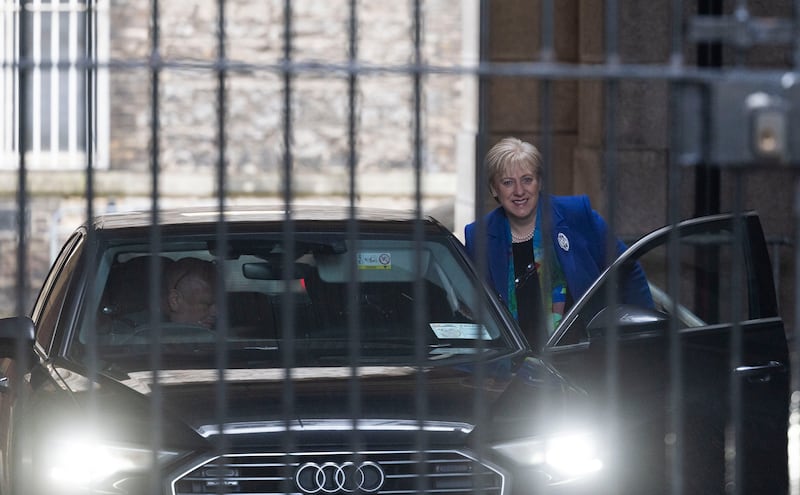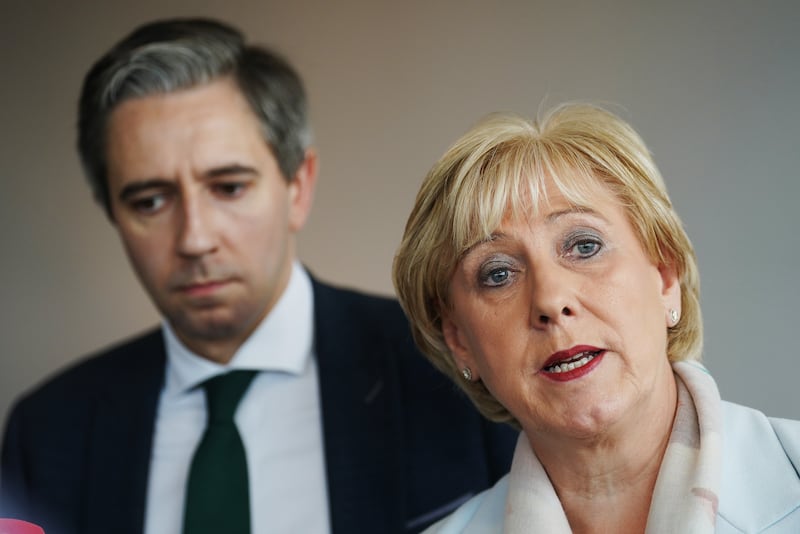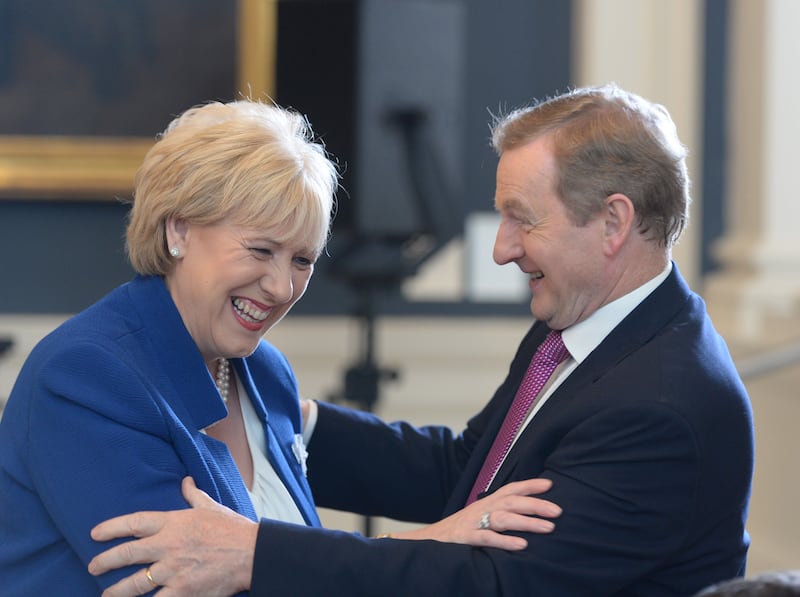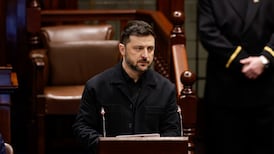Two incidents almost bookend Heather Humphreys’s time as a senior government minister and give an illustration of the self-confidence she acquired over the course of a decade.
Very soon after Enda Kenny plucked her from backbench obscurity to become minister for arts, heritage and the Gaeltacht in the autumn of 2014, she appointed John McNulty to the board of the Irish Museum of Modern Art (IMMA).
McNulty owned a supermarket in southwest Donegal, but until that moment was not known as a connoisseur of cutting-edge visual art. Of course, there was a pretext. He had stood for Fine Gael in the local elections and was about to be chosen for a Seanad byelection to succeed Deirdre Clune, recently elected as an MEP.
Clune had been on the Cultural panel. McNulty’s appointment to IMMA was seen to “qualify” him. It was an old-fashioned stroke and the decision was made above Humphreys’s level, by Kenny himself.
READ MORE
When it became a full-blown controversy, she found herself in the crosshairs of a media onslaught. Deeply ill at ease in the spotlight, she took a battering which quickly raised questions about her wherewithal.
[ From the archive: John McNulty got Imma post within two days of requestOpens in new window ]
She learned from the scorching. “It was a lesson that I took with me for the rest of my career. Prepare. Prepare. Prepare. I never forgot it.”
That change of disposition is clearly manifest from an incident a decade later, in 2023, when two reporters from The Ditch, a news website, arrived at her offices in rural Co Monaghan. They wanted to find out if Humphreys had applied for permission to convert flats in the building into storage space. She has always maintained no permission was required and no wrongdoing has ever been found.
Humphreys asked the two reporters who they were and then said: “Do you know what youse boys can do? F**k off and leave me alone.”
It was curt and, yes, very rude, but it did show that by then nobody had any doubt over Heather Humphreys’s level of self-confidence as a public representative.

When she announced her retirement last October, Humphreys had served as a minister for three Fine Gael leaders and had become something of a John Prescott figure in Fine Gael, hugely popular with the grassroots. She was the minister (along with Michael Ring) who defined rural Fine Gael, and also the one who dismissed Sinn Féin with colourful put-downs.
[ Heather Humphreys defies old line about all political lives ending in failureOpens in new window ]
On a serene January day, the signs of Storm Éowyn are still to be seen in Co Monaghan. Telephone wires are down just outside Ballybay. In the village of Newbliss, there is no phone signal but, not to worry about Eircodes, every local points you to her house.
Humphreys, dressed in a blue trouser suit and neat brogues, ushers you into her comfortable sittingroom with a view of a well-tended garden. Down the road is her childhood home in the hamlet of Drum. In this part of Monaghan there was a big Protestant community, with kith and kin on both sides of the Border.
“We very much feel we are Irish people. I’m an Irish woman. There’s no question about that. We achieved a lot in the new State,” says the practising Presbyterian.
But she adds: “After partition, on this side of the Border it was keep your head down and get on with your lives.”
Seymour came down the avenue and he had a choice to make – turn left for my brother or turn right for me. And he said, ‘They’re looking for a woman. I’ll try her first‘
— Heather Humphreys
Humphreys was born in 1963. Her family, the Stewarts, were farmers and were not political at all. She had a typical rural childhood. There were challenges, though, during the Troubles. “People were concerned the violence would spread south and that Protestants would be a target.”
After secondary school Humphreys joined Ulster Bank and worked in Dublin for a number of years. On moving home, she eventually became manager of the credit union in Cootehill, close to where she lived with her husband Eric and their two daughters.
The job mixed two of her strongest attributes, an acumen for business and her strong roots in the community.
“When I worked in the credit union, it brought me a bit closer to the problems people have. I actually had the power to help them. But you had to be practical too and remind them – somebody said to me, ‘Oh, you’re very good to give me that loan’. I said, ‘Hold on now. I’m selling you money. You’re buying it, and you’re gonna pay me a price for it‘.”
The late Seymour Crawford was the local Fine Gael TD in 2003 when the dual mandate was abolished. Two people on Monaghan County Council were suggested to him as suitable replacements. One was Humphreys, the other was her brother Bert Stewart, who was involved in the IFA. They lived in houses on either side of a road.
“Seymour came down the avenue, and he had a choice to make – turn left for my brother or turn right for me. And he said, ‘They’re looking for a woman. I’ll try her first.‘”
The die had been cast. Humphreys loved being a councillor, and worked closely on an individual basis with colleagues from all parties, including Sinn Féin.

When Crawford retired, she stood for the Dáil in 2011, winning one of three Fine Gael seats in the five-seat constituency. She was reticent in public, made few Dáil speeches, focused her efforts on her constituency and on the finance committee, where she had some expertise to share.
There was a rationale behind her surprise ministerial appointment by Enda Kenny. The centenary year, 2016, was coming up. He thought if the minister who oversaw the commemoration came from the minority tradition, it would send a powerful message of reconciliation.
[ From the archive: Heather Humphreys: 1916 commemorations belong to allOpens in new window ]
“This really was an opportunity for us to look at our history, and it was quite complex, because it was intertwined with the first World War,” she says. Spreading events to encompass a decade of centenaries allowed people to shine a light on a larger period in our history, she adds.
Humphreys believes history will remember Kenny as a great taoiseach, taking the State from the brink of bankruptcy back to growth. “It wasn’t easy during the crash. It was horrible. There was a very strong resolve that Kenny had throughout; he just kept focus.”

By the time Leo Varadkar became taoiseach in 2017, there was no doubt that Humphreys would be retained. Varadkar was different and very direct but she also had a great relationship with him, she says. She says, however, that Simon Harris was the Fine Gael leader to whom she was closest as they were good friends since both entered the Dáil in 2011.
I have a big concern that Sinn Féin policies are not driven by the people who are elected, but driven by others that we don’t know. They want a united Ireland, regardless. Before we can get a united Ireland, we have to have a united people
— Heather Humphreys
Her ministries tended to match her own political strong points. She was minister for enterprise during Brexit, a time where there were real fears of a hard North-South Border reappearing. That, she said, would have been a disaster.
She was minister for social protection during the Covid-19 pandemic, which placed a huge burden on the State. Her other brief in the rural affairs department saw her visit virtually every community in the country, a task she was born for.
She was a huge advocate for linking with Fianna Fáil in 2020. When Micheál Martin unveiled his Shared Island initiative, she told him she believed in it 100 per cent and would back him to the hilt. She believes in a united Ireland, she says, but never in the shape outlined by Sinn Féin. Few others in Fine Gael have criticised Sinn Féin so archly over the years.
“At a national level, we have nothing in common. I have a big concern that Sinn Féin policies are not driven by the people who are elected, but driven by others that we don’t know. They want a united Ireland, regardless. Before we can get a united Ireland, we have to have a united people,” she says.
“There’s no point when you have a cohort which is unhappy, left out, isolated.”
When many of Fine Gael’s TDs announced they would be standing down last year, Humphreys did not look like joining the exodus. She found, however, after the local elections that she was really tired and decided it was time to go.
“I normally bounce back. But after the summer break, I just didn’t have the same energy that I had.”
She says the lack of women ministers in the new Government is a problem, but a complex one.
“For example, it is not easy for a woman when they have small children. If you’re a rural TD it’s very hard as you can’t be at home at night. You have to commit and you have to have a partner who’s willing to take that responsibility.
“And even if you had shorter sittings, I don’t know how you’d solve it. It’s very hard at certain times in a woman’s life to be in politics.”
Invariably, there has been talk about her being a possible Fine Gael candidate for the presidency. Officially, she is retired, but it’s clear she has not closed the door completely.
“I’m not going to do anything for the next three or four months. I have no plans to be honest. But you know what it is like. You can never say no to anything in politics.”
- Sign up for push alerts and have the best news, analysis and comment delivered directly to your phone
- Join The Irish Times on WhatsApp and stay up to date
- Listen to our Inside Politics podcast for the best political chat and analysis


















